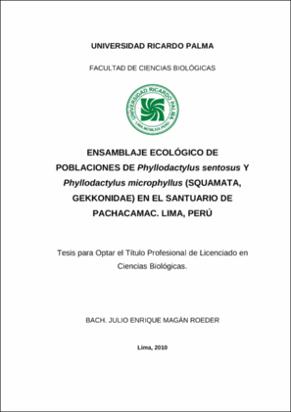| dc.contributor.advisor | Morales Mondoñedo, Victor Raúl | |
| dc.contributor.author | Magan Roeder, Julio Enrique | |
| dc.date.accessioned | 2017-07-18T17:04:51Z | |
| dc.date.available | 2017-07-18T17:04:51Z | |
| dc.date.issued | 2010 | |
| dc.identifier.uri | https://hdl.handle.net/20.500.14138/986 | |
| dc.description.abstract | En el Santuario de Pachacamac encontramos a dos especies de geckónidos nocturnos (Phyllodactylus), siendo las dos de hábitos costeros. Presentando mayor población de Phyllodactylus microphyllus que la otra especie, Phyllodactylus sentosus. Estos geckos tienen actividad nocturna, aparecen desde las horas crepusculares hasta el amanecer. El análisis de contenido estomacal (dieta) determinó que estos geckos consumen cuatro presas por día, prefiriendo dos Órdenes de Insectos: Coleóptera e Hymenóptera. Se comprobó el solapamiento a nivel de Dieta en la especie P. microphyllus entre juveniles y adultos. Gracias a la biometría se observó que la madurez de los juveniles empieza cuando llegan a medir más de 60 mm. La identificación de cuatro hábitats dio a conocer que la especie P. microphyllus prefiere las superficies de arena y P. sentosus prefiere las construcciones arqueológicas. Las especies de geckos se distribuyen con normalidad por todo el territorio del Santuario de Pachacamac, coexistiendo en armonía.
On the Santuario de Pachacamac we found two species of nocturnal geckos (Phyllodactylus), being both of coast habits. Phyllodactylus microphyllus have a mayor population than Phyllodactylus sentosus. These geckos have a nocturnal activity, to show up in twilights hours to sunrise. The analysis of stomach contents (diet) to determine these geckos to consume four preys per day, to prefer two insects Orders: Coleoptera and Hymenoptera. It was found at the level of diet overlap in the species P. microphyllus between juveniles and adults. The identification of four Habitats show us the P. microphyllus prefer sand surface and the P. sentosus prefer the archeologist building. The species of geckos take a normal distribution for all territory of Santuario de Pachacamac. Coexisting in totally harmonious. | es_ES |
| dc.description.sponsorship | Submitted by Wong Rafael (rafel_wl@hotmail.com) on 2017-07-18T17:04:51Z
No. of bitstreams: 1
Magan_je.pdf: 2705156 bytes, checksum: e90382d16fe700002a847a7cb838f2f0 (MD5) | es_ES |
| dc.description.sponsorship | Made available in DSpace on 2017-07-18T17:04:51Z (GMT). No. of bitstreams: 1
Magan_je.pdf: 2705156 bytes, checksum: e90382d16fe700002a847a7cb838f2f0 (MD5)
Previous issue date: 2010 | es_ES |
| dc.description.uri | Tesis | es_ES |
| dc.format | application/pdf | |
| dc.language.iso | spa | |
| dc.publisher | Universidad Ricardo Palma - URP | es_ES |
| dc.rights | info:eu-repo/semantics/openAccess | |
| dc.rights.uri | https://creativecommons.org/licenses/by-nc-nd/4.0/ | |
| dc.source | Repositorio Institucional - URP | es_ES |
| dc.subject | Coleóptera e Hymenóptera, | es_ES |
| dc.subject | dieta | es_ES |
| dc.subject | hábitats | es_ES |
| dc.subject | Phyllodactylus | es_ES |
| dc.subject | Santuario de Pachacamac | es_ES |
| dc.subject | Coleoptera and hymenoptera | es_ES |
| dc.subject | diet | es_ES |
| dc.subject | habitats | es_ES |
| dc.subject | Phyllodactylus | es_ES |
| dc.title | “Ensamblaje ecológico de poblaciones de Phyllodactylus sentosus y Phyllodactylus microphyllus (SQUAMATA, GEKKONIDAE) en el Santuario de Pachacamac - Lima, Perú.“ | es_ES |
| dc.type | info:eu-repo/semantics/bachelorThesis | |
| thesis.degree.discipline | Biología | es_ES |
| thesis.degree.grantor | Universidad Ricardo Palma. Facultad de Ciencias Biológicas. Escuela Profesional de Biología | es_ES |
| thesis.degree.level | Título Profesional | es_ES |
| thesis.degree.name | Licenciado en Biología | es_ES |
| dc.publisher.country | PE | es_ES |
| renati.type | https://purl.org/pe-repo/renati/type#tesis | |
| renati.level | https://purl.org/pe-repo/renati/nivel#tituloProfesional | |
| renati.discipline | 511206 | |
| dc.type.version | info:eu-repo/semantics/publishedVersion | |


